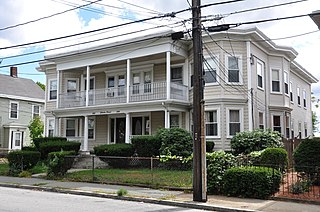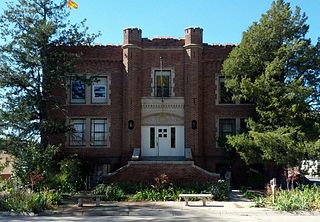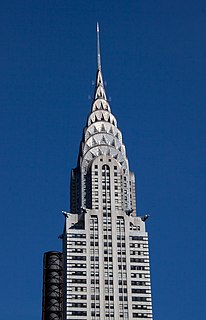
There are more than 1,500 properties and historic districts in Colorado listed on the National Register of Historic Places. They are distributed over 63 of Colorado's 64 counties; only Broomfield County has none.

The Batavia Depot Museum is a museum in Batavia, Illinois that was once the town's primary train station. It was the first of many depots built by the Chicago, Burlington and Quincy Railroad. It was listed on the National Register of Historic Places in 1979 as the Chicago, Burlington, and Quincy Railroad Depot.

Art's Auto is a historic former service station at 5–7 Lonsdale Avenue in Pawtucket, Rhode Island. It is a single-story brick structure with a flat roof and a series of towers capped by pointed roofs. It was built as an automotive service station in 1927–28 for Arthur Normand at a time when gasoline producers competed, in part, by the shape and style of their service stations. This station is one of two stations known to survive from this period in the state. Its front facade has a dramatic presentation, with square towers topped by pyramidal roofs at the corners, and a projecting round bay in the center topped by a conical roof, with windows arrayed around the bay and on its flanks. The building is currently used as an office for Anchor Financial. Art's Auto was listed on the National Register of Historic Places in 1978.

The Engine House is an historic former fire station at Court and Spring Streets in downtown Auburn, Maine, USA. Built in 1879, it is one of the few surviving 19th-century fire stations in the state of Maine. It was listed on the National Register of Historic Places in 1978.

The Building at 202–204 Charles Street in Waltham, Massachusetts is a well-preserved example of multi-unit residential housing built in the city in the early decades of the 20th century. It was built in 1913, and was listed on the National Register of Historic Places in 1989.

The Niagara Engine House is located on North Hamilton Street in downtown Poughkeepsie, New York, United States. It is a brick building constructed in the early 20th century, the only extant fire house of the six engine companies that once protected the city.

First Trust Building and Garage, also known as Lloyd's Bank, is a historic 1927 building located on Colorado Boulevard in Pasadena, California. The building was designed by Cyril Bennett and Fitch Haskell; its design incorporates the Mediterranean Revival, Renaissance Revival, and Beaux-Arts styles. The design features decorative exterior stonework, a red tile hip roof topped with a cupola, and a frieze and balustrade on the south facade. The building's interior is decorated with murals depicting scenes from around Pasadena. Caltech professor R. R. Martel designed the building's earthquake-proof support system, which uses steel beams and girders with reinforcing concrete; the system was considered an important advancement in earthquake-proof construction and became a standard form of construction.

The Hotel Iowa, also known as the Pierce Building, is a historic building located in downtown Keokuk, Iowa, United States. It was built from 1912–1913 and it was listed on the National Register of Historic Places in 1987.

The Riverside Studio in Tulsa, Oklahoma, United States, also known as Tulsa Spotlight Club or Spotlight Theatre, was built in 1928. It was designed by architect Bruce Goff in International Style. It was built as a house with a studio wing for a music teacher named Patti Adams Shriner. The Riverside Studio was listed on the U.S. National Register of Historic Places in 2001 under Criterion C.

The Hugo Municipal Pool, in Hugo, Colorado, was built during 1936-38. It is located at the junction of US 287 and 6th Ave. Its building was designed by Lloyd E. Heggenberger and built by the Works Progress Administration in what has come to be known as WPA Moderne style. It was listed on the National Register of Historic Places in 2008.

The Cotton Belt Railroad Office Building is a historic commercial building at 312 East Broad Street in Texarkana, Arkansas. Built c. 1910, this two-story brick building is one of the oldest buildings in downtown Texarkana. Its exterior walls have been stuccoed, and it has a flat roof behind a stuccoed brick parapet. It has vernacular Italianate styling, with two-story pilasters separating the front bays, and dentil molding at the roof line. The main facade is divided into three bays, the central one providing the main entry on the first floor, and an arched-top window above. The flanking bays are plate glass on the first floor, with tripled sash windows above. The building's first tenant was the Cotton Belt Railroad, whose arrival was responsible for Texarkana's significant growth in the early 20th century.

The Burlington Traction Company is a historic trolley maintenance facility at Riverside Avenue and North Winooski Avenue in Burlington, Vermont. The property includes two brick trolley barns, built c. 1900 and c. 1910 respectively, that were used as public transit maintenance facilities until 1999, after which they were adaptively repurposed to other residential and commercial uses. The property was listed on the National Register of Historic Places in 2004.

The Dumas Tenements are a pair of four-unit apartment buildings, set back-to-back at 114 West Allen and 114 West Canal Streets in Winooski, Vermont. Built about 1907 by a French Canadian immigrant, they are among the only buildings of their type to survive the city's urban redevelopment efforts of the late 20th century. They were listed on the National Register of Historic Places in 2012.

The Fairfield Street School is a historic school building at 78 Fairfield Street in the city of St. Albans, Vermont. Built in 1911, it served as a school until 1970, and is now converted into residential use. It is a prominent local example of Colonial Revival architecture, designed by Burlington architect Frank Lyman Austin. It was listed on the National Register of Historic Places in 1996.

The Normand House is a historic residential property at 163-65 Intervale Avenue in Burlington, Vermont. Built in 1869 as a single-family and enlarged into three units in 1890, it is a well-preserved example of period worker housing. It was listed on the National Register of Historic Places in 2008.

The Charles R. Palmer House is a historic house at 201-203 North Willard Street in Burlington, Vermont. Built about 1911, it is a well-preserved example of an American Foursquare duplex in the city's Old North End neighborhood. It was listed on the National Register of Historic Places in 2005.

The Willard Manufacturing Company Building is a historic factory building at 25 Stowell Street in the city of St. Albans, Vermont. Built in 1896, the building saw industrial uses continuously until 2006, retaining many original early period features. It was listed on the National Register of Historic Places in 2006.

Wise Feed Company Building, also known as the Motor Mart Garage Building, is a historic commercial building located at Springfield, Greene County, Missouri. It was built about 1930, and is a two-story, rectangular tan brick commercial building. It has a flat roof and rests on a concrete foundation. It features decorative brickwork on the front facade.

Sargent's Garage, also known as the Robinson's Paint and Body Shop, Grand Spring Body and Paint Company, and Fabio's, is a historic building located in Des Moines, Iowa, United States. Completed in 1924, this single-story commercial building emplifies vernacular commercial architecture. It features a rectangular plan, wood siding now covered with metal, and a flat roof. It originally had a symmetrical facade, which has now been altered. Its significance is that it is an early automobile repair and body shop, which was a new architectural form that was emerging in early 20th-century Iowa. It continued to serve this purpose until 1997 when it suffered a minor fire. The building sat vacant for a period of time until it was renovated and reopened. It was listed on the National Register of Historic Places in 1998.

























